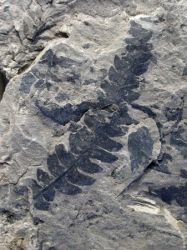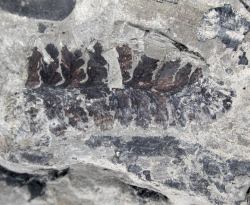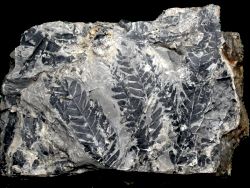Ferns from Yorkshire
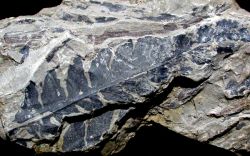 A
common fern is Eboracia lobifolia (click on the photo to the left;
Eboracum is the Latin name for York). The foliage resembles that of Todites
williamsonii very much, but the axes are more slender. Todites:
thick axes, Eboracia: thinner axes. A second difference is that in
a complete pinna the basal leaflet in Eboracia differs from the other
leaflets (larger and split in segments), while they are all the same in
Todites. Furthermore the leaflets of Eboracia are somewhat
undulated while those of Todites look more rigid.
A
common fern is Eboracia lobifolia (click on the photo to the left;
Eboracum is the Latin name for York). The foliage resembles that of Todites
williamsonii very much, but the axes are more slender. Todites:
thick axes, Eboracia: thinner axes. A second difference is that in
a complete pinna the basal leaflet in Eboracia differs from the other
leaflets (larger and split in segments), while they are all the same in
Todites. Furthermore the leaflets of Eboracia are somewhat
undulated while those of Todites look more rigid.
Eboracia belongs to the Dicksionaceae family, which has the sporangia
arranged in groups (sori) along the borders of the leaflets.
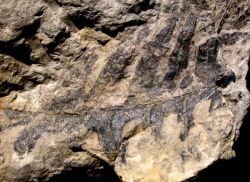 The
(rather large) leaves of Dictyophyllum rugosum are reminiscent of
leaves of modern, flowering plants, because they show a reticulate venation.
Mostly only fragments are found but these are easily recognisable. Click
on the photo on the right.
The
(rather large) leaves of Dictyophyllum rugosum are reminiscent of
leaves of modern, flowering plants, because they show a reticulate venation.
Mostly only fragments are found but these are easily recognisable. Click
on the photo on the right.
Dictyophyllum is a species from the Dipteridaceae, the only one
still living fern family with real reticulate venation.
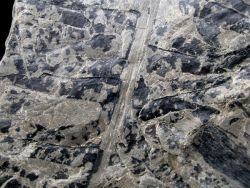 Phlebopteris polypodioides is also a plant with living relatives
(family Matoniaceae). The leaflets are characterized by angular veins, sometimes
forming a partly reticulate pattern (click on the photo on the left). Furthermore
the sori (if present) are arranged parallel to the midrib.
Phlebopteris polypodioides is also a plant with living relatives
(family Matoniaceae). The leaflets are characterized by angular veins, sometimes
forming a partly reticulate pattern (click on the photo on the left). Furthermore
the sori (if present) are arranged parallel to the midrib.
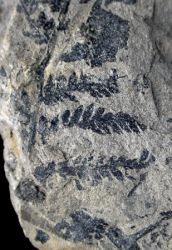 Klukia
exilis is a small fern which can be found rather easily in the Gristhorpe
Plant Bed, but which is rare elsewhere in the Yorkshire area. It is a guide
fossil for the Middle Jurassic. The leaflets are attached
Pecopteris-like, i.e. with a broad base. Click on the photo to the
right.
Klukia
exilis is a small fern which can be found rather easily in the Gristhorpe
Plant Bed, but which is rare elsewhere in the Yorkshire area. It is a guide
fossil for the Middle Jurassic. The leaflets are attached
Pecopteris-like, i.e. with a broad base. Click on the photo to the
right.
Klukia exilis is a member of the Schizaeaceae, a fern family
with relatively large sporangia, each placed apart on the lower side of the
leaflets along the secondary veins.
In Hayburn Wyke fossils of the genus Coniopteris are abundant, but they occur also in other places, however less frequent. They are ferns with strongly branched leaves, which are, however, in most cases severely damaged before fossilizing. Almost always one finds detached pinnae or parts thereof.
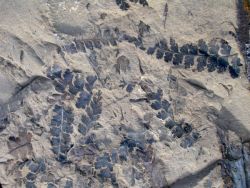 The
species Coniopteris hymenophylloides (because of the difficult name
also informally called Conhym) is very common. Fertile as well as sterile
leaves are found and these are rather different: the fertile leaflets are
strongly reduced. Click on the photo on the left.
The
species Coniopteris hymenophylloides (because of the difficult name
also informally called Conhym) is very common. Fertile as well as sterile
leaves are found and these are rather different: the fertile leaflets are
strongly reduced. Click on the photo on the left.
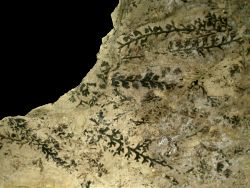 The
leaflets of Coniopteris simplex are divided in small lobes and thus
rather easy to distinguish from those of 'Conhym'. Click on the photo on
the right. This species is common in Hayburn Wyke.
The
leaflets of Coniopteris simplex are divided in small lobes and thus
rather easy to distinguish from those of 'Conhym'. Click on the photo on
the right. This species is common in Hayburn Wyke.
Coniopteris murrayana has overlapping leaflets and pinnae, but
this is not a reliable feature. It is better to look at the form of the basal
leaflet of a pinna (but regrettably these are rarely preserved). In Conhym
the first basal leaflet on the lower side of the pinna is finely divided
(aphlebia-like), while in Coniopteris murrayana just the first basal
leaflet on the upper side is finely divided ... I haven't found a convincing
specimen of Conmur.
Just like Eboracia, Coniopteris belongs to the Dicksionaceae
family.
